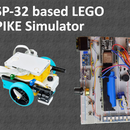Introduction: Pocket Power Supply
Hello,
This unit was a by-product of another project. I needed a small power supply on the field that can give 12VDC. I did not want to carry a huge benchtop power supply so I made a battery powered packet size power supply. I used one 18650 Li-Ion battery, which has the best energy density feature among available batteries on the market. I used a step-up boost converter module, which changes the 3.7V of the battery to a higher voltage. The output Voltage is adjustable in the range of 5 V…24VDC. There is a small potentiometer on the module for this purpose. The switched-mode power supply has a very good efficiency (approximately 90%). Without any cooling, it was capable of producing 600 mA at 12VDC (7.2W) (only for a short time). I put a USB connector as an output of the unit because this was the easiest way for me to connect to different loads. The output voltage and current are displayed with a USB tester. After the output Voltage is set, there is no need for any display (it consumes some energy, shortening the lifetime of the battery), so I just remove the USB tester, before using the unit for a longer time. I created a video with step by step instruction to show how to build this useful tool, and I made some test, to see the performance of the unit.
It is very simple to build the power supply, for someone who likes soldering, creating this unit will take 10 minutes.
Step 1: BOM List
USB Male Connectors 1 pc https://www.aliexpress.com/item/10-pcs-USB-Male-Co...
18650 Battery Holder 1 pc https://www.aliexpress.com/item/High-Quality-1865...
18650 Battery 1 pc free from old laptop battery or https://www.aliexpress.com/item/4PCS-battery-1865...
XL6009 DC Adjustable Step up boost Power Converter Module 1 pc https://www.aliexpress.com/item/XL6009-DC-Adjusta...
Cable 1 pc free from ATX power supply or https://www.aliexpress.com/item/5m-Red-5m-Black-S...
Total material cost of the project: 4,85 $/total project
Step 2: Assembly Process
Every step of the assembly process can be seen in the first step video.
Some additional information to the video:
The cables came from an ATX power supply, the battery came from a used laptop battery.
The unit has no housing, and no circuit protection. Be careful, in the case of a polarity problem or overload the module can break down can cause a fire. When I put the battery in the holder with the wrong polarity, the input diode soldered out itself. You can watch the
whole process in the attached video. I made it unintentionally, but now I call it battery reverse polarity test.:). I will do some changes that it won't happen again. I will apply this protection module: https://www.aliexpress.com/item/Protective-plate-...
This module will give protection against deep discharging and overvoltage. If this will work, I will do another Instructables article.
Cable all the components according to the schematic. Apply screws to fix all modules to the battery holder.
A did not put a battery charger on the unit, because I have more independent chargers like the attached picture. And I have more batteries, so I can charge and use the unit parallel.
Step 3: Tests and Final Words
First, I tested the unit with a simple ventilator, then I connected an adjustable load. The result was promising. I set up the load to 600 mA at 12VDC (7.2W) I used a laser thermometer to see the temperature of the module. After a few second the temperate of the DC/DC module increased over 50 C. I shout down the test at this point. I believe over 50 C the IC will be damaged in a short time. There is room for a passive cooling, but it will increase the weight of the unit. I will apply if it is necessary.
I have used this power supply for a few times without any problem, I can carry it in my pocket. I plan to create a housing maybe some cooling.
Have a nice day!













